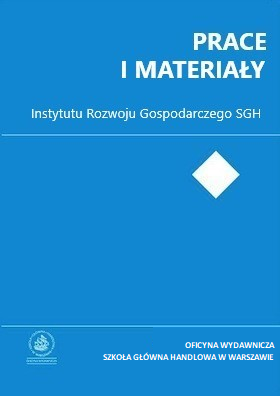The HSE ESI and the Business Cycle in the Russian Economy
##plugins.themes.bootstrap3.article.main##
Abstrakt
As the Russian economy is presently characterized by high uncertainty of doing business and a growing gap between opinions and actions of firms and decision makers, the importance of qualitative business surveys as a source of information is significantly rising. The paper investigates the ability of Russian business tendency surveys to identify business cycle turning points. For this purpose we have constructed an algorithm to build economic indicators which cover all information contained in the sectoral business surveys data. Identification of the turning points of these indicators allows us to track the stylized 'averaged' chronology of the business cycle. In addition, we have evaluated ex post the turning points in the GDP growth on the basis of the extracted cyclical component of the composite Economic Sentiment Indicator. (original abstract)
##plugins.themes.bootstrap3.article.details##
Bibliografia
Bry, G., Boschan, C. (1971). Cyclical analysis of time series: Selected procedures and computer programs. NBER Technical Paper 20.
Chauvet, M., Hamilton, J. D. (2005). Dating business cycle turning points.
NBER Working Paper No. 11422.
European Commission (2014a). The joint harmonised EU programme of business and consumer surveys. User guide. URL: http://ec.europa.eu/ economy_finance/db_indicators/surveys/documents/bcs_user_guide_en.p df (usage date: 10.03.2015).
European Commission (2014b). European business cycle indicators. URL: http://ec.europa.eu/economy_finance/publications/cycle_indicators/2014/ pdf/ebci_2_en.pdf.
Fulop, G., Gyomai, G. (2012). Transition of the OECD CLI system to a GDP-based business cycle target. URL: http://www.oecd.org/std/ leading-indicators/49985449.pdf (usage date: 10.04.2015).
Gayer, C. (2008). Report: The Economic Climate Tracer. A tool to visualise the cyclical stance of the economy using survey data. URL: http://ec.europa.eu/economy_finance/db_indicators/surveys/documents/st udies/economic_climate_tracer_en.pdf (usage date: 14.03.2015).
Kitrar, L., Lipkind, T., Ostapkovich, G. (2014). Decomposition and joint analysis of growth cycles in time series of the Economic Sentiment Indicator and the Gross Domestic Product. Voprosy statistiki (Statistical Issues), 9, 41-46 (in Russian).
Kitrar, L., Ostapkovich, G. (2013a). Special features and implementation of the indicator approach to cyclical monitoring of economic dynamics.
Voprosy statistiki (Statistical Issues), 8, 42–50 (in Russian).
Kitrar, L., Ostapkovich, G. (2013b). Integrated approach to construction of composite indicators with built-in algorithm for cycle evaluation in time series of the business tendencies monitoring results. Voprosy statistiki (Statistical Issues), 12, 23–34 (in Russian).
Kitrar, L., Pogosova, L., Nilsson, R. (2003). Business cycles and cyclical indicators in Russia. URL:http://www.oecd.org/officialdocuments/public displaydocumentpdf/?cote=CCNM/STD(2003)2&docLanguage=En (usage date 20th Aug 2014).
Mitchell, J., Smith, R. J., Weale, M. R. (2002). Aggregate versus disaggregate survey-based indicators of economic activity. National Institute of Economic and Social Research Discussion Paper, 194.
Lucas, R. E. (1981). Studies in business cycle theory. Cambridge, Mass.
Nilsson, R., Guidetti, E. (2008). Predicting the business cycle. Statistics Brief, 14, 1-14.
Nilsson, R., Gyomai, G. (2011). Cycle extraction. A comparison of the PAT method, the Hodrick-Prescott and Christiano-Fitzgerald filters. URL: http://www.oecd.org/std/leading-indicators/41520591.pdf (usage date 10.03.2015).
OECD (2014a). Main economic indicators (MEI). URL: http://www.oecd.org /std/oecdmaineconomicindicatorsmei.htm (usage date 20.05.2015).
OECD (2014b). The OECD economic outlook. URL: http://www.oecd.org/eco/economicoutlook.htm (usage date 20.05.2015).
OECD (2012). System of composite leading indicators. URL: http://www.oecd.org/std/leading-indicators/41629509.pdf (usage date 20.05.2015).
OECD (2008). Handbook on constructing composite indicators. URL: http://www.oecd.org/std/leading-indicators/42495745.pdf (usage date 20.05.2015).
OECD. (2003). Business tendency survey. A handbook. URL: http://www.oecd.org/std/leading-indicators/31837055.pdf (usage date 15.04.2015).
Smirnov, S. (2001). A system of leading indicators for Russia. Voprosy Economiki (Economic Issues), 2, 23-42 (in Russian).
Smirnov, S. (2006). A new system of leading indicators for Russia. 28th CIRET Conference paper, Rome. URL: http://www.hse.ru/data/2012/ 05/31/1252356146/48.pdf (usage date 15.05.2015).
Smirnov, S. (2014). Russian cyclical indicators and their usefulness in real time: an experience of the 2008-09 recession. Journal of Business Cycle Measurement and Analysis, 1, 103-128.
Stock, J. H., Watson, M.W. (2010). Estimating turning points using large data sets. NBER Working Paper 16532.
